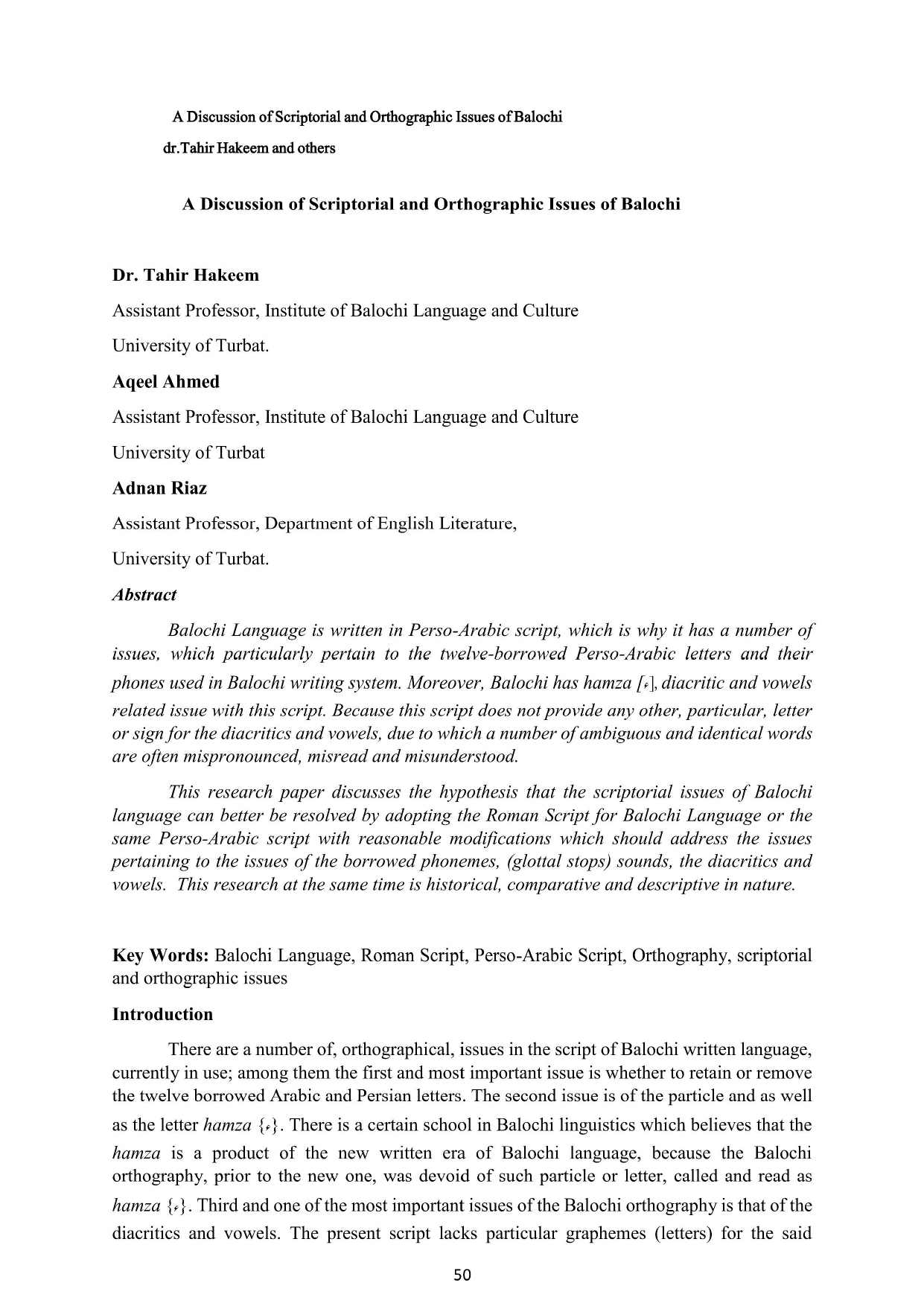Discussion of Scriptorial and Orthographic Issues of Balochi
Keywords:
Balochi Language, Roman Script, Perso-Arabic Script, Orthography, scriptorial and orthographic issuesAbstract
Balochi Language is written in Perso-Arabic script, which is why it has a number of
issues, which particularly pertain to the twelve-borrowed Perso-Arabic letters and their
phones used in Balochi writing system. Moreover, Balochi has hamza [ء], diacritic and vowels
related issue with this script. Because this script does not provide any other, particular, letter
or sign for the diacritics and vowels, due to which a number of ambiguous and identical words
are often mispronounced, misread and misunderstood.
This research paper discusses the hypothesis that the scriptorial issues of Balochi
language can better be resolved by adopting the Roman Script for Balochi Language or the
same Perso-Arabic script with reasonable modifications which should address the issues
pertaining to the issues of the borrowed phonemes, (glottal stops) sounds, the diacritics and
vowels. This research at the same time is historical, comparative and descriptive in nature.
References
Besenval, R. (1993). The 1992-1993 field-seasons at Miri Qalat: new contributions to the chronology of Protohistoric settlement in Pakistan Makran. Journal of South Asian Archaeology, 1.
Hughes, A. W. (1977). The Country of Balochistan: its Geography, Topography, Ethnology, and History. Quetta: Gosha-e-Adab.
Jarrige, J. (2006). Mehrgarh Neolithic. International Seminar on the First Farmers in Global Perspective. Lucknow, India.
Jarrige, J. F. (1995). Mehrgarh: Field Reports 1974-1985 from Neolithic times to the Indus civilization. (J.-F. J. Cattherin Jarrige, Ed.) Karachi: the department of culture and tourism, Govt of Sindh in collaboration with the Fechch Ministry of Foreign Affairs.
Kenoyer, J. M. (1998). Ancient Cities of the Indus Valley Civilization. Krachi: Oxford University Press.
Kenoyer, J. M., & Heuston, K. (2005). The Ancient South Asian World. Oxford: Oxford University Press.
Qazi, M. N. (1998). Prehistoric Cultures of Pakistan: An Introduction. In F. D. Ali (Ed.), The Glory that was Pakistan, 50 year of Archaeological Research in Pakistan. Peshawar: Department of Archaeology, University of Peshawar and Nationall Heritage Foundation.
Shaffer, J. G. (1992). The Indus Valley, Baluchistan and Helmand Tradtitons: Neolithic Through Bronze Age. (e. b. (3rd ed.), Ed.) In Chronologies in Old World Archaeology.
Shaffer, J. G., & Lichtenstein, D. A. (1995). The concepts of "cultural tradition" and "palaeoethnicity" in South Asian Archaeology. In The Indo-Aryans in Ancient South Asia: Language, Material Culture and Ethnicity ed by DeGruyter, G. Erdosy and W. Berlin.
Stein, S. A. (1931). An Archaeological Tour in Gedrosia. In Memoirs of the Archaeological Survey of India (Vol. 43). Calcutta: Government of India Central Publication Branch.
Stein, S. A. (1932, rept 1991). An Archaeological Tour in Waziristan and Northern Balochistan. Memoirs of the Archaeological Survey of India, 37.
Thomas, R. M. (2011). Analysis of a protohistoric net from Shahi Tump, Baluchistan. .in Archaeol Anthropl Sci, Pblished online:28 October,2011.


